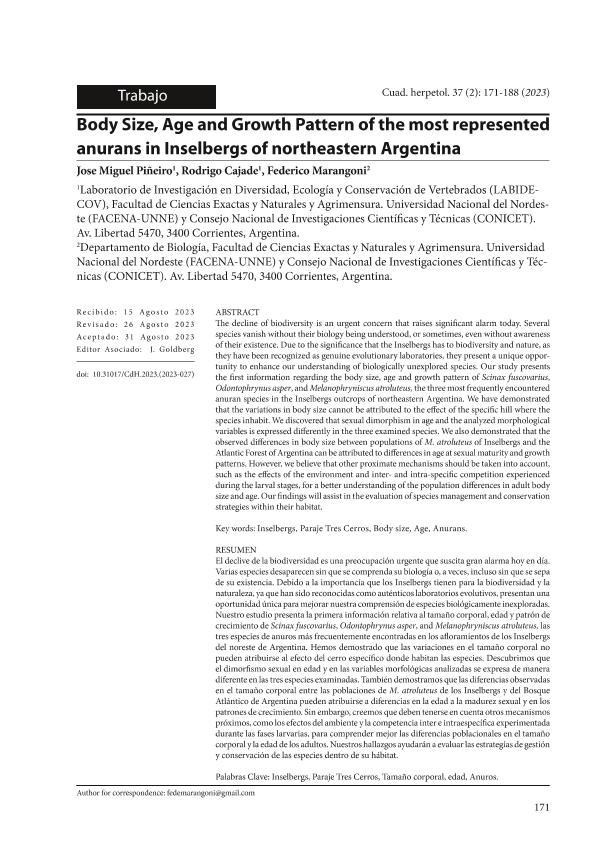Artículo
The decline of biodiversity is an urgent concern that raises significant alarm today. Severalspecies vanish without their biology being understood, or sometimes, even without awarenessof their existence. Due to the significance that the Inselbergs has to biodiversity and nature, asthey have been recognized as genuine evolutionary laboratories, they present a unique opportunity to enhance our understanding of biologically unexplored species. Our study presentsthe first information regarding the body size, age and growth pattern of Scinax fuscovarius,Odontophrynus asper, and Melanophryniscus atroluteus, the three most frequently encounteredanuran species in the Inselbergs outcrops of northeastern Argentina. We have demonstratedthat the variations in body size cannot be attributed to the effect of the specific hill where thespecies inhabit. We discovered that sexual dimorphism in age and the analyzed morphologicalvariables is expressed differently in the three examined species. We also demonstrated that theobserved differences in body size between populations of M. atroluteus of Inselbergs and theAtlantic Forest of Argentina can be attributed to differences in age at sexual maturity and growthpatterns. However, we believe that other proximate mechanisms should be taken into account,such as the effects of the environment and inter- and intra-specific competition experiencedduring the larval stages, for a better understanding of the population differences in adult bodysize and age. Our findings will assist in the evaluation of species management and conservationstrategies within their habitat. El declive de la biodiversidad es una preocupación urgente que suscita gran alarma hoy en día. Varias especies desaparecen sin que se comprenda su biología o, a veces, incluso sin que se sepa de su existencia. Debido a la importancia que los Inselbergs tienen para la biodiversidad y la naturaleza, ya que han sido reconocidas como auténticos laboratorios evolutivos, presentan una oportunidad única para mejorar nuestra comprensión de especies biológicamente inexploradas. Nuestro estudio presenta la primera información relativa al tamaño corporal, edad y patrón de crecimiento de Scinax fuscovarius, Odontophrynus asper, and Melanophryniscus atroluteus, las tres especies de anuros más frecuentemente encontradas en los afloramientos de los Inselbergs del noreste de Argentina. Hemos demostrado que las variaciones en el tamaño corporal no pueden atribuirse al efecto del cerro específico donde habitan las especies. Descubrimos que el dimorfismo sexual en edad y en las variables morfológicas analizadas se expresa de manera diferente en las tres especies examinadas. También demostramos que las diferencias observadas en el tamaño corporal entre las poblaciones de M. atroluteus de los Inselbergs y del Bosque Atlántico de Argentina pueden atribuirse a diferencias en la edad a la madurez sexual y en los patrones de crecimiento. Sin embargo, creemos que deben tenerse en cuenta otros mecanismos próximos, como los efectos del ambiente y la competencia inter e intraespecífica experimentada durante las fases larvarias, para comprender mejor las diferencias poblacionales en el tamaño corporal y la edad de los adultos. Nuestros hallazgos ayudarán a evaluar las estrategias de gestión y conservación de las especies dentro de su hábitat.
Body Size, Age and Growth Pattern of the most represented anurans in Inselbergs of northeastern Argentina
Fecha de publicación:
09/2023
Editorial:
Asociación Herpetológica Argentina
Revista:
Cuadernos de Herpetología
ISSN:
0326-551X
e-ISSN:
1852-5768
Idioma:
Inglés
Tipo de recurso:
Artículo publicado
Clasificación temática:
Resumen
Palabras clave:
INSELBERGS
,
PARAJE TRES CERROS
,
BODY SIZE
,
AGE
,
ANURANS
Archivos asociados
Licencia
Identificadores
Colecciones
Articulos(CCT - NORDESTE)
Articulos de CTRO.CIENTIFICO TECNOL.CONICET - NORDESTE
Articulos de CTRO.CIENTIFICO TECNOL.CONICET - NORDESTE
Citación
Piñeiro, Jose Miguel; Cajade, Rodrigo; Marangoni, Federico; Body Size, Age and Growth Pattern of the most represented anurans in Inselbergs of northeastern Argentina; Asociación Herpetológica Argentina; Cuadernos de Herpetología; 37; 2; 9-2023; 171-188
Compartir
Altmétricas




